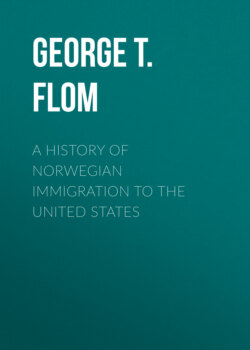Читать книгу A History of Norwegian Immigration to the United States - George T. Flom - Страница 8
На сайте Литреса книга снята с продажи.
Оглавление“This event was one of the most glorious in the Society’s history. The reception was held at the City Tavern, Wednesday evening, December eleventh, 1782. The President of the St. Andrew’s Society, Rev. Wm. Smith, D. D., lauded the bravery of the Baron and his men at the Battle of Yorktown, whereupon General Washington in thanking the members of the Society for their forethought in tendering the reception to the noble officer (he subsequently decorated Ferson with the “Order of the Cincinnati” for valor displayed) expressed his pleasure at being present among the people of his forefathers’ blood, as he claimed descent from the family of Wass, who emigrated from Denmark in the year AD 970, and settled in the County Durham, England, where they built a small town, calling it Wass-in-ga-tun (town of Wass.)”[26]
In January, 1783, General George Washington was elected honorary member of the Society on account of his Norse ancestry. On the twenty-sixth of August, that year, a banquet was given at the City Tavern under the auspices of the Society, in celebration of the recognition by Sweden, Norway, and Denmark of the independence of the United States of America. John Stille was for many years secretary of the Society; after his death in 1802 all traces of it seem to have vanished. Just when the Societies Scandinaviensis ceased to exist, the Historian cannot say. On February twentieth, 1868, eighteen gentlemen, all of Scandinavian birth and residents of Philadelphia, met together for the purpose of forming a society, and The Scandinavian Society of Philadelphia was founded, an organization which regards itself a continuation of the original society. The chief object of the Society is benevolence.
The name of at least one Norwegian who fell in the early wars against the Indians has come down to us. Frank Peterson, who had enlisted on the fifteenth of June, 1808, was among those who fell at Fort Dearborn in 1812, among the “first martyrs of the West,” in an attack by five hundred Pottawattamie Indians. In this battle two-thirds of the whites were killed and the rest taken prisoners.
At a later date some other names also appear, but those given are the only ones of which we have any record. I shall mention here that of Ole Haugen, who probably was the first Norwegian to settle in the State of Massachusetts. Haugen was from Bergen, Norway, and located in Middlesex County, that state, in 1815. Alexander Paaske, himself an early immigrant from Bergen, living in Lowell, Mass., and who was present at Haugen’s deathbed, is the source of the above fact. Though going beyond the scope of our brief survey of this earliest immigration, it may be of interest here to know that as early as 1817, a girl from Voss, Norway, Anna Vetlahuso, emigrated to America with her husband, a German sailor in Bergen, and settled somewhere in South America. The next recorded names in the order of emigration to the United States are Kleng Peerson and Knud Olson Eide, who in 1821 became the advance guard of a group of fifty-two emigrants that in 1825 founded the first Norwegian settlement in this country. It is of this sailing and the leaders of this group that I now wish to speak; of Peerson I shall give a brief account below.
